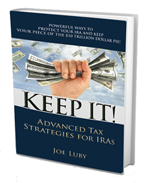Bankruptcy Protection for IRAs
Categories: Retirement StrategiesThe number of bankruptcy filings in the U.S. steadily increased from 2008-2010. 2011 showed a slight decrease from 2010, but there were still 83% more filings in 2011 than in 2007. (All results as of September 30; Source http://www.uscourts.gov/Statistics/BankruptcyStatistics.aspx).
For tax and financial planning professionals, this means a greater risk that one of your clients has filed bankruptcy…or will file at some point. In the event of this unfortunate circumstance, it is important to understand the rules surrounding IRAs and how these assets may be protected.
Under the Bankruptcy Abuse Prevention and Consumer Protection Act of 2005 (BAPCPA), debtors have extended protections for their IRAs. Generally, one must select either the applicable state law or federal law to determine what assets are exempt from forfeiture during the bankruptcy proceeding. The BAPCPA leveled the playing field and allows debtors to essentially select the better of the two choices for their IRAs.
This article deals specifically with the protections afforded IRAs under the federal law. More specifically, we will review the protections for accounts which consist solely of IRA contributions and earnings thereon and not rollover contributions from other qualified plans.
These contributory IRAs were allowed complete exemption up to $1,000,000 under the BAPCPA. Additionally, this amount is indexed over time for inflation. As of 2012, the statutory exemption amount for contributory IRAs is $1,171,650. A unique provision in the bankruptcy code also allows for an unlimited increase in this amount “if the interests of justice so require.” It would be interesting to know what the drafters of this provision had in mind as “interests of justice” in this regard! In any case, professional advisors should plan around the $1.17 million figure.
The key to protecting as much as possible within the debtor’s IRA is to understand that the $1.17 million of value protected is defined as the fair market value (FMV) of the account as of the date of filing (Title 11 Section 522(a)(2)). Thus, it is vitally important that the IRA statement reflect the most accurate FMV of all the assets owned.
For IRAs holding traditional marketable securities and cash, the FMV is easy to determine and probably adequately reported on the account statement. However, alternative investments such as non-listed REITs, hedge funds, private investment funds, limited partnerships, BDCs, private equity investments and others are often shown at their original cost basis. It is common to find such assets in IRAs where the FMV has not been updated over a long period of time because there were no taxable events to require a more up to date valuation. In many cases, the current FMV will be considerably lower than the value shown on the account statement and thus the IRA value is overstated.
If the IRA statement shows an overstated value which is higher than the bankruptcy exemption limit, then it is in the best interests of the IRA owner to get the accurate FMV reported by the IRA custodian prior to filing the petition for bankruptcy. For example, assume an IRA owns an alternative asset with a cost basis of $1.5 million and that is the amount still shown on the account statement. In this case, over $300,000 of value is at risk in a bankruptcy proceeding because the total account value is greater than the exemption amount of $1.17 million. If the IRA owner obtains an updated appraisal reflecting the current FMV of the asset as only $1.125 million (a 25% discount), he/she can report this updated information to the IRA custodian who can then properly update the account valuation. The entire IRA will then be properly exempt from the bankruptcy proceeding.
Well informed advisors can be very valuable even in cases where clients are financially distressed and going through bankruptcy. Advisors can help protect client assets and continue to manage and advise on such assets since they will not be forfeited if handled properly.
Author: Joe Luby, ®
©2012 All Rights Reserved.


Comments are closed.